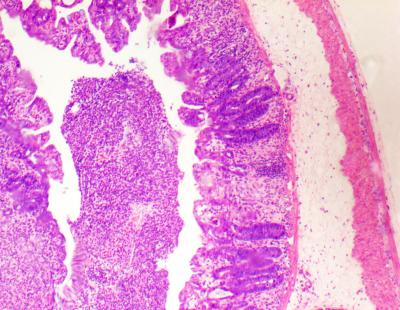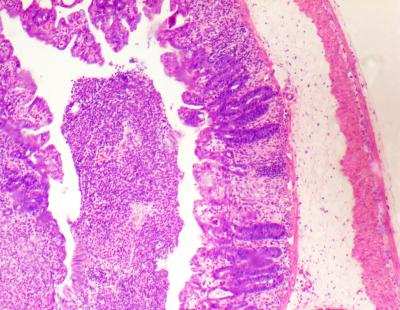
Credit: Pedro Faísca, IGC.
In a recent study published in Cell Reports, a research team led by Colin Adrain, from the Instituto Gulbenkian de Ciencia (IGC, Portugal), discovered the mechanism that controls the release of important molecules that trigger the inflammatory response during the clearance of infections. When this machinery is deregulated it can contribute to important chronic diseases such as inflammatory bowel disease, arthritis, and cancer.
Most proteins involved in communication between cells reside on the cell surface, hooked to the membrane. This is the case for the inflammatory molecule, TNF. When TNF is released from the membrane, it binds to its receptor on the cell surface, activating a cascade of events that change the cell's behaviour fundamentally, preparing the cell and surrounding tissue to fight infection. However, TNF is deregulated in a range of inflammatory diseases and is therefore the focus of several therapeutic strategies.
"Therapies for anti-inflammatory diseases focus on blocking the action of TNF. Although anti-TNF therapies are currently being used to treat patients, they do not always work efficiently. If we can understand the machinery that controls the release of TNF, we may be able to identify new targets that will allow us to intervene in a more specific, or more potent, way towards inflammatory diseases", explained Colin Adrain.
In this work, Adrain's team were able to pinpoint the precise molecular mechanisms involved in TNF release. It was already known that TNF molecules are cut from the cell surface by an enzyme called TACE that acts as "molecular scissors" to release TNF and other important molecules from the cell. Now, the researchers observed that the key to controlling these "scissors" lies on the regulation of a protein called iRhom2. "This places iRhom2 at the core of the regulatory machinery for TNF release from cells", said Miguel Cavadas, the first author of the study.
An important feature of the newly identified mechanism is that the same protein, iRhom2, is important for controlling the release of growth factors that trigger cellular growth associated with many serious epithelial cancers.
###
The work was conducted and supported at the IGC and was funded by Worldwide Cancer Research, an international cancer research charity. Researchers from Instituto de Tecnologia Quimica e Biologica (ITQB-NOVA; Portugal), University of Edinburgh (UK), and Universität Wien (Austria) collaborated in this study.
*Cavadas, M., Oikonomidi, I., Gaspar, C.J., Burbridge, E., Badenes, M., Félix, I., Bolado, A., Hu, T., Bileck, A., Gerner, C., Domingos, P.M., von Kriegsheim, A., Adrain, C. (2017) Phosphorylation of iRhom2 Controls Stimulated Proteolytic Shedding by the Metalloprotease ADAM17/TACE. Cell Reports, 21:3, 745-757. http://dx.doi.org/10.1016/j.celrep.2017.09.074
Media Contact
Ana Mena
[email protected]
351-214-407-959
@IGCiencia
http://www.igc.gulbenkian.pt
Related Journal Article
http://dx.doi.org/10.1016/j.celrep.2017.09.074





